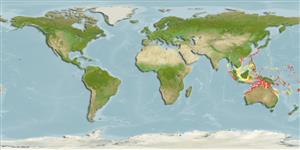Environment: milieu / climate zone / depth range / distribution range
Ökologie
seewasser riff-verbunden; tiefenbereich 3 - 50 m (Ref. 90102). Subtropical
Western Pacific: Japan and Australia.
Size / Gewicht / Alter
Maturity: Lm ? range ? - ? cm
Max length : 2.3 cm SL Männchen/unbestimmt; (Ref. 48637)
Kurzbeschreibung
Morphologie | Morphometrie
Rückenflossenstacheln (insgesamt): 7; Rückenflossenweichstrahlen (insgesamt): 7-8; Afterflossenstacheln 1; Afterflossenweichstrahlen: 7 - 8. Characterized by having semi-transparent body with dusky stripe on side of snout; presence of broad reddish brown stripe from rear eye to dorsal surface of abdomen and along ventral body to caudal fin base; pectoral rays unbranched and not thickened; longitudinal scale series 33-41; shallow cup, pelvic disc; opening of gill usually reaching to below middle or rear half of eye (Ref. 90102).
Occurs on lagoon reefs and hovers upside-down among thickets of the staghorn coral Acropora formosa (Ref. 37816, 48637). Often seen resting on underside of coral branches and makes short forays into water column to feed on planktons (Ref 90102).
Life cycle and mating behavior
Geschlechtsreife | Fortpflanzung | Ablaichen | Eier | Fecundity | Larven
Nakabo, T., 2002. Fishes of Japan with pictorial keys to the species, English edition II. Tokai University Press, Japan, pp 867-1749. (Ref. 43239)
IUCN Rote Liste Status (Ref. 130435)
Bedrohung für Menschen
Harmless
Nutzung durch Menschen
Mehr Information
NamenSynonymeMetabolismusRäuberÖkotoxikologieFortpflanzungGeschlechtsreifeAblaichenSpawning aggregationFecundityEierEientwicklung
Alter/GrößeWachstumLänge-GewichtLänge-LängeLängenhäufigkeitenMorphometrieMorphologieLarvenLarven Pop.Dyn.RekrutierungDichteBRUVS
ReferenzenAquakulturAquakultur ProfilZuchtlinienGenetikElectrophoresesVererbbarkeitKrankheitenVerarbeitungNutrientsMass conversion
PartnerBilderStamps, Coins Misc.LauteCiguateraGeschwindigkeitSchwimmstilKiemenoberflächeOtolithsGehirngrößeSehfähigkeit
Tools
Zusatzinformationen
Download XML
Internet Quellen
Estimates based on models
Preferred temperature (Ref.
123201): 26.1 - 28.9, mean 27.8 °C (based on 300 cells).
Phylogenetic diversity index (Ref.
82804): PD
50 = 0.5000 [Uniqueness, from 0.5 = low to 2.0 = high].
Bayesian length-weight: a=0.00708 (0.00333 - 0.01504), b=3.09 (2.92 - 3.26), in cm total length, based on LWR estimates for this (Sub)family-body shape (Ref.
93245).
Trophic level (Ref.
69278): 3.1 ±0.3 se; based on size and trophs of closest relatives
Widerstandsfähigkeit (Ref.
120179): hoch, Verdopplung der Population dauert weniger als 15 Monate. (Preliminary K or Fecundity.).
Fishing Vulnerability (Ref.
59153): Low vulnerability (10 of 100).
Nutrients (Ref.
124155): Calcium = 289 [94, 921] mg/100g; Iron = 1.64 [0.60, 4.09] mg/100g; Protein = 18.2 [16.0, 20.2] %; Omega3 = 0.172 [0.051, 0.546] g/100g; Selenium = 18.3 [4.4, 61.8] μg/100g; VitaminA = 72.1 [11.2, 447.5] μg/100g; Zinc = 3.11 [1.48, 5.71] mg/100g (wet weight);
